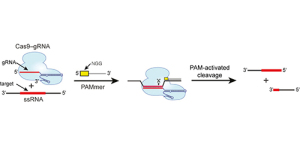The advent of the CRISPR/Cas9 genetic editing tool is already generating novel therapies for diseases and will create new opportunities for pathologists and medical laboratories
In just 24 months, a new gene-editing tool has become the hot topic worldwide among researchers working to understand DNA and develop ways to manipulate it for therapeutic purposes. It goes by the acronym CRISPR and it may soon become quite familiar to most pathologists and medical laboratory scientists.
CRISPR stands for clustered regularly interspaced short palindromic repeats. The gene editing platform is known as CRISPR/CAS9.
CRISPR/Cas9 Platform Allows Scientists to Edit Human DNA
Two researchers developed CRISPR/Cas9. Jennifer Doudna, Ph.D., who holds appointments at the University of California Berkeley (UC Berkeley), at Howard Hughes Medical Institute, and at Lawrence Berkley National Lab, worked with Professor Emmanuelle Charpentier, Ph.D., a researcher who heads the Department of Regulation in Infection Biology at Helmholtz Centre for Infection Research and Hannover Medical School in Germany to develop a system for editing DNA, noted a report published by the Boston Globe.

Pictured above is University of California Berkley Professor Jennifer Doudna, Ph.D., who along with Emmanuelle Charpentier, Ph.D., a researcher at the Helmholtz Centre for Infection Research and Professor at Hannover Medical School in Germany, developed the CRISPR/Cas9 genomic editing platform. The two scientists also recently announced development of RCas9, an RNA editing tool that may make it possible to direct RNA transcription detection, analysis, and manipulation. (Copyright Howard Hughes Medical Institute.)
This genomic editing system mimics a how bacteria’s immune system naturally sheds viruses. The process involves slicing the genome with great precision to edit out disease-causing DNA and replace it with DNA synthesized in a lab.
Their study, which was published in the journal Science, August 17, 2012, demonstrated how the technology could be customized to snip DNA strands at specific spots in a laboratory dish.
Within months of publication of this paper, George Church, Ph.D., a Professor of Genetics at Harvard Medical School (HMS), and Feng Zhang, Ph.D., who is an Assistant Professor at the Massachusetts Institute of Technology (MIT), a core member of the Broad Institute and Harvard, as well as an investigator at the McGovern Institute for Brain Research at MIT, began demonstrating the power of the technique to cut genes in mouse and human cells.
“I’m a technology junkie—an early adopter of all kinds of technology, not just biology, and it’s very rare to see something like this,” said Church in the Boston Globe article. His laboratory did the early work to demonstrate how this technique could be used to “edit” genes in human cells. “As soon as we started playing with it in the lab, it became evident that not only was it something that worked well and worked efficiently, it was super easy to do,” he said.
Researchers Are Already Developing Therapeutics Using CRISPR/Cas9
Rapid adoption of CRISPR/Cas9 by researchers worldwide is now generating applications for therapeutic uses in humans. Using stem cells, scientists at the Boston Children’s Hospital, for example, are employing this technique to correct gene mutations that cause β-thalassemia, a common genetic blood disease caused by mutations in the human hemoglobin beta (HBB) gene. Their research was published in the online edition of the journal Genetic Research, August 5, 2014.
Scientists at the Harvard Stem Cell Institute also have demonstrated how it is possible to edit blood-forming stem cells. Using the CRISPR/Cas9 system they were able to delete a gene called CCR5 that the HIV virus needs to infect blood cells.
Additionally, it is providing help for researchers at Harvard, who have used this gene editing system to disrupt genes and lower cholesterol in mice. Scientists at MIT also are using it to rapidly engineer mice with liver tumors, noted the Boston Globe report.
Scientists are now establishing startups dedicated to using CRISPR/Cas9 to create medications and therapeutics to treat the underlying cause of specific diseases. A Cambridge-based company, Editas Medicine, for instance, was founded by researchers to translate genome editing technology into a novel class of medications and therapies that enable precise and corrective molecular modification to treat a broad range of diseases at the genetic level, according to the company’s website.
Novartis and Partners to Use CRISPR/Cas9 to Develop Novel Drugs
Big Pharma is also engaged in gene-editing research. Pharma giant Novartis, for example, entered contracts in January 2015 with Intellia Therapeutics and Caribou Biosciences to develop new drugs using the CRISPR/Cas9 genome editing system, reported a story published by Genetic Engineering News (GEN News).

The schematic above shows how RNA-guided Cas9, working with PAM-presenting oligonucleotides (PAMmer) can target single-stranded RNA (ssRNA) for programmable, sequence-specific cleavage. (Copyright Jennifer Doudna Laboratory, UC Berkeley)
Doudna and Charpentier Have Announced New Editing Platform for RNA
Most recently, Doudna and Charpentier, whom are candidates for a Nobel Prize, have also programmed the CRISPR/Cas9 platform to recognize and slice RNA at sequence-specific target sites, reported a Gen News article. Researchers say that this advancement, which is called “programmable RNA recognitions and cleavage by CRISPR/Cas9” (RCas9), may make it possible to direct RNA transcription detection, analysis, and manipulation.
Pathologists and clinical laboratory managers scientists will want to keep a close eye on therapeutic developments using this editing tool, as it is likely to generate new laboratory tests to diagnose genetic mutations underlying many diseases and health conditions, so they can be targeted with novel treatments generated using CRISPR/Cas9.
—Patricia Kirk
Related Information:
Tool to edit DNA revolutionizing research in Boston area
A Programmable Dual-RNA–Guided DNA Endonuclease in Adaptive Bacterial Immunity
CRISPR/Cas9 Can Now Edit RNA, Not Just DNA
Gene Editing Will Change Everything—Just Not All at One Time
Genomic Editing Draws Near the Clinic
Novartis Launches CRISPR Collaborations with Intellia, Caribou



